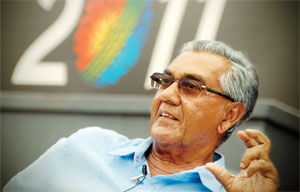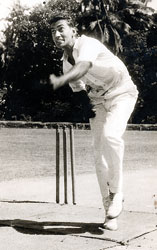It’s debated by cricket crazy fans that Anuruddha Polonowita could help win your team the match. A spinner might want from him a dry, dusty pitch that would allow the ball to careen in at an angle no batsmen could predict; a pacie a little moisture, a little grass, just enough to allow his fast balls to accelerate till they become a blur heading for the wickets. Sri Lanka’s genial National Curator will turn 73 this July, and though the year has barely begun it is already one of the most challenging of his long career. He has brought nearly five decades of experience to managing multiple pitches across three stadiums for the ICC World Cup 2011 with the country being joint hosts for the event along with India and Bangladesh.
Along the way, he has worked weekends and holidays, dodged angry cricketers, and juggled the requirements of the organisers, the Cricket Board and the fans. It’s enough to exhaust anyone but when we first meet him, the spry ex-cricketer looks like he still has a match or two in him.
 |
| Ready for the bouquets as well as the brickbats: Anuruddha Polonowita.
Pic by Sanka Vidanagama |
On Tuesday, out in the blazing sun he was inspecting the pitch. Row upon row of now empty seats at the R. Premadasa Stadium would have been filled with roaring fans when Sri Lanka faced England and later when the stadium hosts the World Cup semi-final. “We started preparing these pitches for the World Cup four or five months back,” he tells us, explaining that the stadium is constructed over marshy land that used to be a landfill.
To get the pitch ready for the matches, Mr. Polonowita has raised the whole ground by 3 ½ feet. “We decided on a gradient of 90 to 1...usually we use a gradient of 100 to 1,” he explains saying that the steeper slope helps direct the rising moisture to the perimeter drains that ring the field.
A relentless opponent, the moisture seeps out especially over the course of cool nights. During the monsoons, it’s a battle the grounds- men might lose as often as they win. Unlike Australia or England, Sri Lankan cricket fields are put to hard use year round. Under Mr. Polonowita managing the grounds has become an art and a science. “In those days it was the ‘meenachis’ and ‘natamis’ who were doing the grounds using lawn mowers and hand rollers,” he says. Initially with the blessing of the late President Ranasinghe Premadasa, Mr. Polonowita began to turn things around. Hand rollers have been replaced by shiny 3 tonne machines, but beyond that the curator has raised his team’s professional standards – today 7 agriculture degree holders oversee multiple teams made up of 20 groundsmen. They’ve all been personally trained by Mr. Polonowita, who was himself trained as a curator at the Melbourne Cricket Ground in Australia.
Annual workshops keep them ahead of the curve.
If the pitch is simply a strip of hard mud to you, all this care might seem excessive. However, the brown patch is in fact a creation of many layers, the consistency and ingredients of which must be carefully judged. There’s a nine inch layer of rubble followed by one of sand. Another layer allows moisture to seep through and one made of anthill earth keeps the moisture in. Topping these is yet another made of pot clay. Then there is the layer of Blue grass (another variety known as Bermuda Santana covers the field). Its maintenance presents its own challenges.
“If you take a Test Match we start the preparation of the pitch a week before,” he says, explaining that if the weather is inclement than they will often stop watering the pitch. Every day, the grass is mown a little bit more, until by the fourth or fifth day it is all but gone. Barred from watering the pitch while the game is on, the team watches their grassy strip turn into a dusty, dehydrated spinner’s wicket. The preparations for a one day event are equally distinctive – here the objective is to ensure the fans aren’t disappointed. “In 15 overs, four or five wickets falling quickly means there’s no match,” says Mr. Polonowita who tries to ensure the pitch stays dry and in prime condition.
“A good pitch will create an even bounce,” he explains, “the ball should come on to the bat where the batsman can play strokes and the outfield should be dry and fast so that the ball will travel – these are all the details we have to look into.” For all his care, Mr. Polonowita’s pitches have their share of detractors. “When we win, they’re very happy, they don’t even look at you. When we lose, the whole blame comes on us. We’re ready for that,” he says philosophically.
“ We always try to cater for the toss-winning side to bat,” says Mr. Polonowita. Even so last year, the Indians were unhappy, and now the quality of the pitch is said to have affected Australia’s game against Pakistan. “People ask why Australia couldn’t get runs,” says Mr. Polonowita sharing his opinion that “they misjudged the wicket and tried to play big shots without grafting runs and building up a score... They are international players; they should know how to read the pitch.”
 |
| ‘Polons’ the cricketer |
Mr. Polonowita has dealt with many international cricketers, including two captains of the national team whom he trained himself as a coach at Ananda (Marvan Atapattu and Arjuna Ranatunga, the latter famed as the only captain so far to lead Sri Lanka to a World Cup victory). Over the course of a distinguished career, ‘Polons’ himself has played cricket for his country and coached as many as 25 cricketers who went on to do the same.
Firmly attached to the Sri Lanka Cricket Board, he has served as Vice President, Ground Secretary and headed several umpires, tournament and selection committees. Working with the Colombo Municipality for 40 years, he doubled the number of Community centres. He also found the time to set up 23 pre-schools for less privileged children in Colombo. He has served under 13 Cricket Board Presidents and an equal number of Mayors and survived all the interim committees in between because he puts the game first. “I respect the chair, I listen to them and I serve cricket...I like to work with people not against them.”
He has also worked closely with two presidents. As with President Premadasa, he has worked closely with President Mahinda Rajapaksa over the construction of another stadium - the Suriyawewa stadium in Hambantota. Despite the criticism, Mr. Polonowita is a staunch defender of the project – “I’m proud to be working for another president and building another big stadium for him,” he says, happy that Sri Lanka offers world class facilities. Declaring Suriyawewa an investment for the future, Mr. Polonowita shares his belief that the stadium will inspire young people from the region to go into professional cricket and notes that it has already hosted some of the largest crowds in Sri Lanka.
Here, as in the Pallekele stadium in Kandy, Mr. Polonowita intends to keep everything pitch perfect. “I have done 130 odd one day pitches after we got ICC member status and about 77 test pitches, and out of that Sri Lanka has happily won more than 85% of the matches.
The only emotion that outshines his devotion to cricket is one he reserves for Chitranjani Polonowita, his wife of 38 years and their three children and grandchildren. He’ll take his first vacation in a year with his two daughters in Australia as soon as the matches are done. In the meantime, he’s exactly where he wants to be. For the man who first fell in love with the sport as a ten-year-old, “cricket is a way of life.” |



